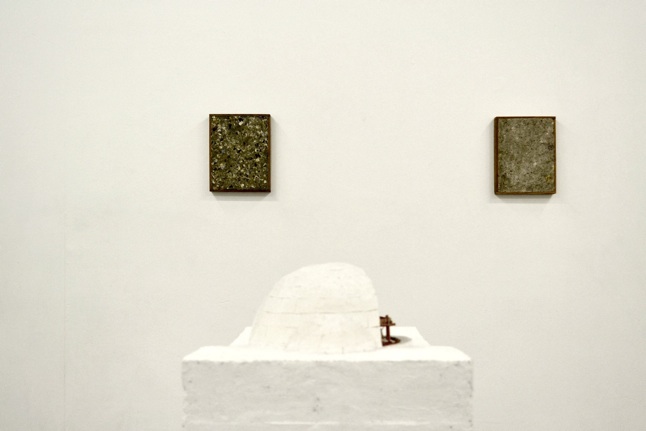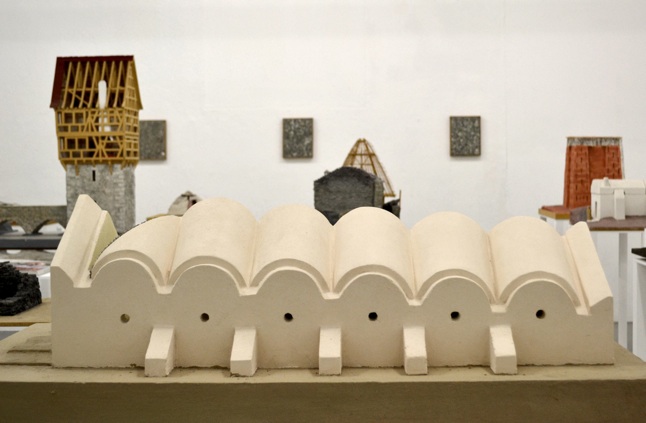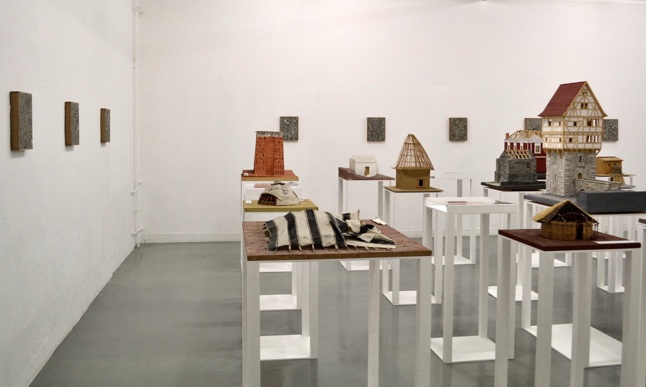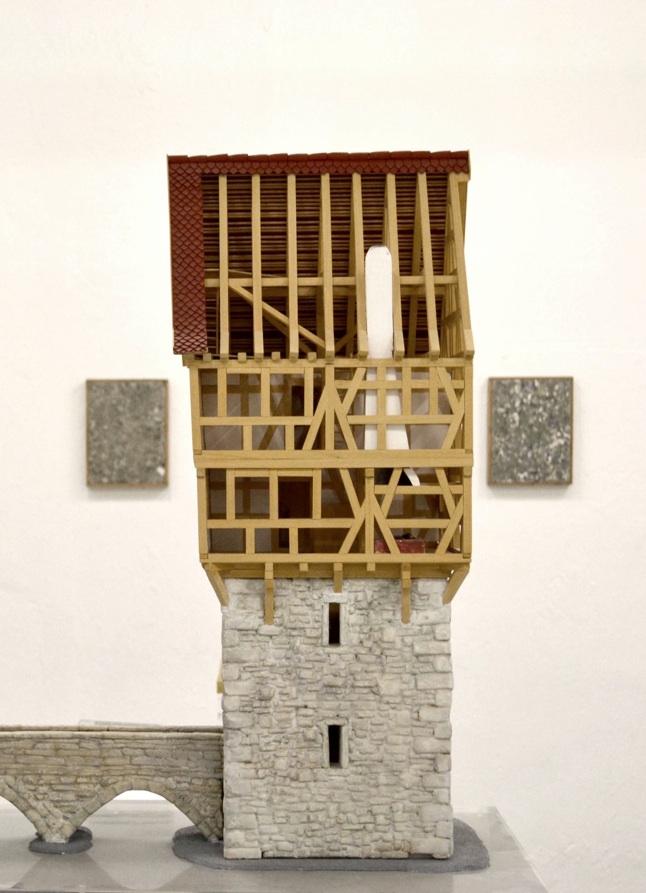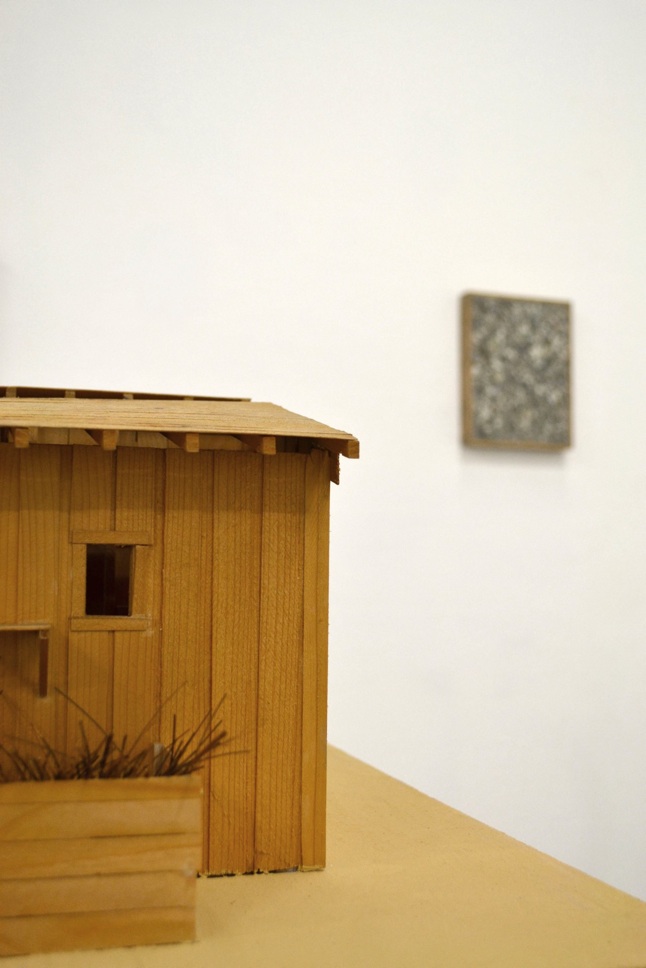Towards a vernacular architecture
Prof. Pierre Frey, Oscar Tuazon
26.01 - 25.02.2012

Oscar Tuazon, I can't see (papercrete edition), 2011. Courtesy of the artist and DoPe.
Forde presents a selection of vernacular architecture models from Lausanne’s Federal Institute of Technology’s Learning from Vernacular collection, for which Prof. Pierre Frey is responsible, as well as a new series of works by the American artist Oscar Tuazon, entitled Papercretes.
15.02.2012, 19h
Vers une nouvelle architecture vernaculaire, lecture by Prof. Pierre Frey
-
--
Towards a vernacular architecture : A chronology in the form of a bibliography
In 1923, Le Corbusier publishes his book manifesto Vers une architecture, with a chapter dedicated to volume, illustrated with a sequence of photographs of grain silos in the United States. These raised cylinders both encapsulate his fascination for a symbiosis between form and function and give a modern and visionary resonance to his very famous definition of architecture as masterly, correct and magnificent play of masses brought together in light.
Vers une architecture was published in English under the title Towards a New Architecture in 1927. What Le Corbusier implied in the reading of the French title as a move towards a thoroughly contemporary form of architecture is explicitly tinged with the modern fantasy of novelty, in the English translation. This difference, four years after the original edition, highlights the work’s projective and authoritarian dimension. What the architect condemns is the regression of architecture through the repetition of anachronistic styles. He celebrates the forms created by engineers, through calculation, as the emergence of architecture from the mind.
Bernard Rudofsky publishes Architecture without Architects in 1964, the same time as he presents the eponymous exhibition at the MoMA. He hopes to highlight the architectural, plastic, functional and technological qualities of vernacular architecture and invites architects to switch their gaze from the modernist dogmas and learn about pre-modern margins. He thereby challenges the architect’s authority and that of his signature. It is also a way for him to highlight the lack of documentation concerning this architecture without pedigree.
From two years before that and until 1992, Frédéric Aubry, professor at the Federal Institute of Technology in Lausanne (EPFL), creates a collection of models representing vernacular architecture. Over 30 years, the professor and his students make nearly 700 models. This collection represents a multicultural database designed to feed the imaginations of young architects. It is both a catalogue of expertise and a repertoire of forms, of integration solutions for an ecosystem or social system.
In 1968, Robert Venturi and Denise Scott Brown take a group of students to Las Vegas to check their hypotheses on the emergence of a new architectural model. The city’s characteristic strip, a huge commercial street to drive down, forms the basis of an architectural theory based on a concrete observation, reversing the initial modernist theory of the tabula rasa. The book Learning from Las Vegas: the Forgotten Symbolism of Architectural Form that appears in 1972 revolutionises the ordinary understanding of architectural thinking as much as it upsets the heroic architecture establishment inherited from modernism. The work is a powerful iconographical essay that borrows its methods both from anthropology and artists such as Ed Ruscha.
The English writer and architect, Colin Ward, has shown an anarchistic approach towards architecture and urban planning, notably in his book entitled Housing: An Anarchist Approach, published in 1973. He makes the link between Henry David Thoreau’s nonconformist approach and the emergence of punk by, for example, taking an interest in the architect, Walter Segal, and the idea of self-build homes. Colin Ward extends these ideas by defending squats.
- -
Born in 1975, Oscar Tuazon said in the Seattle Times on 9th May 2008 that, to him, the forgotten counter-history of minimalism is the do-it-yourself architecture happening at the same time. The artist is developing a practice that combines the formal revolution of minimal art (in line with modernist ideology) with alternative housing models. There, where American artists from the 1970s have sought to remove their stamp from their work, Oscar Tuazon superimposes emancipatory energy from alternative movements. With the industrialisation of artwork, he opposes a traditional model by drawing his material from what the industrial society produces as rubbish, and avoids the economy. In 2009, he edits a reprint of the book Vonu, The Search for Personal Freedom by Rayo. Vonu is a term that means a lifestyle striving to escape coercion (invulnerability to coercion). He is showing a new series of Papercretes at Forde, bas-reliefs produced using an alternative construction method that appear as monochromes.
Professor Pierre Frey, in charge of the Archives de la Construction Moderne (Modern Construction Archives) at the EPFL, has been tasked by the institute to value the collection amassed by Frédéric Aubry. In 2010, he publishes a book entitled Learning from Vernacular: Pour une nouvelle architecture vernaculaire. It is a manifesto against spectacular dominant architecture, a tool asserting power. The author questions the social role of the architect in a context where cosmogonies translated in some forms of vernacular architecture are replaced by “views of the world” that contemporary architects sell their clients.



